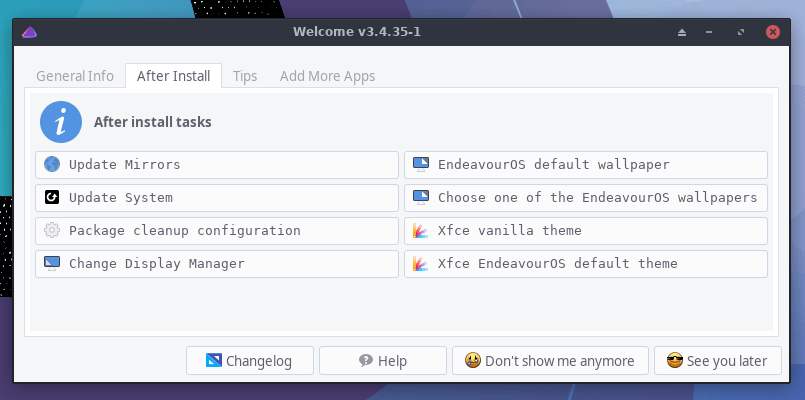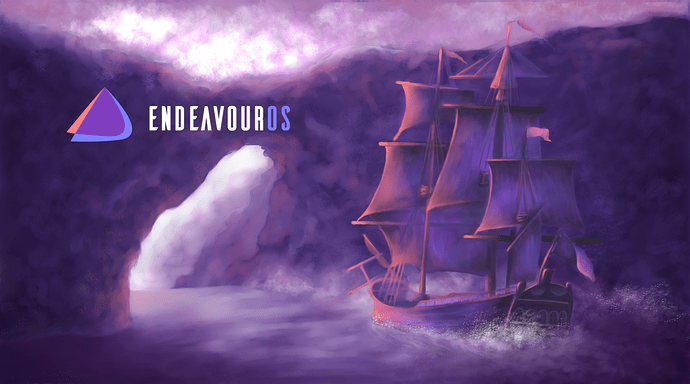

These statements are:Īnd they can be added to the. There are several ways of making this happen (see the Archwiki for more) – my solution involves adding 3 statements entered in a file that will be executed when you start up – such as. XFCE is a GTK-based setup, and it can be better to have the QT apps looking similar if you can. The final ‘tweak’ is a global setting to inform those applications that use the QT decoration scheme that you wish a size increase of its UI elements.
Endeavouros windows#
As you see, I move them left (where they were before Windows degraded workflow), and I hide the menu button. By the way – this is also where you can choose which window control buttons you wish to use, and where they are located on the titlebar. I run with an assortment of XFCE-38px (Found on and – I like the ones by Ollifri for example – found dated from about April 2018) options, which, again, I find comfortable – and allow sufficient room for the upsized font you chose in the step before. There are many themes that can be downloaded, and some of them specify the size in pixels of the toolbar. pause and stop buttons in a music player for example) to be set up. This leaves only the size of such things as toolbars (play. Again, you can set the font appropriately, probably to the same size (12, 13, 14) as you opted for in the previous section. The Window Manager handles the Titlebars and their text, and the ‘outside envelope’ of the window. Now, in the Window Manager app, under the Style tab, there are a couple of more changes worth doing. 12 might do it, 13 is probably OK, but I’m a bit older so I choose 14 on both as a workable and non-tiring option.

Increase these until you are reading comfortably. Now that you can see a bit better, you can choose a font size that works for you in the Default Font and Default Monospace Font categories. Just above this, on the same screen, is the rendering setting – where I would recommend you check the “Enable anti-aliasing” box, and select Slight for the font hinting. One of the most useful settings is to change to 120 dpi – which is a substantial step up without trying to double everything. Most setups first come up with 96 dpi selected as standard. In Settings/Appearance/Fonts/DPI there is an opportunity to make a change. The Steps to a more nuanced setting for HI-DPI screens The example I use is what I actually run with on my 28 inch 3840×2160 monitor.
Endeavouros full#
This may be made more flexible in the future, but for now… other options are better.Īssuming neither of these appeal to you, there are a number of steps you can take which will give you more flexibility – keeping your full resolution – while still allowing you to see the UI and the text clearly.

This enables a scaling factor for the system to apply, but it only takes whole numbers (1 or 2 or 3 etc.) which keeps your choices limited. This one works the right way around, a scale factor of 2 will double the size of the screen elements. Take a look here at the Settings/Appearance/Settings screen:Īgain, there is a Scaling option in the Settings/Appearance/Settings/Window Scaling. However – if you want to keep your full resolution (especially for graphics), but still want to be able to see and use the features of the User Interface (UI) and the text on the screen, there are other ways. This works well, and the system can remember your settings and fire up graphic sessions in that mode thereafter. Strangely, it works the opposite way to what you would expect – choosing 2x will seem to shrink your windows and fonts to half-size, for example, giving you lots of screen real estate, but requiring a magnifying glass to read anything! If I were using this method, I would choose Custom, and a value of perhaps 0.7 – growing the size of the screen contents to about 150%.

There is also a Scale option there that allows changing apparent size as well (this is shown as the active choice in the screenshot above). Another choice might be (depending on your hardware) 2560×1440, which would give you about 75% of the original resolution – or an increase in size of about 150% of the features (and fonts!) on your screen. If you have, for example, a 3840×2160 monitor, you could choose 1920×1080 as your resolution – giving you half the screen real-estate, with items on it at double the size. One is to use the Settings/Display application,Īnd select the resolution you consider correct for your use. If you would be happy with such a change, there are two ways to achieve it. To begin – here is a screenshot of the Settings app for XFCE.įirst off, there is a possibility that you would be happy with a simple scaling change, that changes the effective resolution to a value other than what you actually have. Some things to do with a Hi-DPI screen on XFCE


 0 kommentar(er)
0 kommentar(er)
